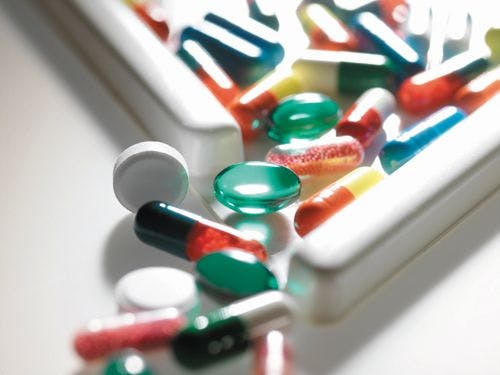Chromatographers Get Into Cannabis
Gas chromatography (GC) is an established and well-understood technique. As the cannabis industry grows, demand for analytical robustness is increasing for analytes such as pesticides, residual solvents, and terpenes. GC and GC coupled to mass spectrometry (GC–MS) are effective tools to address the demands of laboratories, growers, manufacturers, and consumers. This article provides an overview of the types of compounds that can be analyzed by GC, reviews the strengths and weaknesses of the analytical methods, and discusses areas of opportunity for chromatography.
Photo Credit: David Malan/Getty Images

Gas chromatography (GC) is an established and well-understood technique. As the cannabis industry grows, demand for analytical robustness is increasing for analytes such as pesticides, residual solvents, and terpenes. GC and GC coupled to mass spectrometry (GC–MS) are effective tools to address the demands of laboratories, growers, manufacturers, and consumers. This article provides an overview of the types of compounds that can be analyzed by GC, reviews the strengths and weaknesses of the analytical methods, and discusses areas of opportunity for chromatography.
The word on the street is that cannabis is going to be big business. Already a multi-billion-dollar market in the U.S., a conservative estimate of the analytical portion of this business is around $100 million, with some estimates going even higher.
1
Medical and recreational cannabis and manufactured products are becoming legal in more and more states in the U.S. and in countries worldwide, and the need for reliable chemical analysis has skyrocketed. One of the most common analytical instruments in this new industry is gas chromatography (GC), a solid workhorse for an emerging challenge. Generally speaking, many of the analyses needed in the cannabis industry would be familiar to those from environmental and food testing laboratories: pesticides, mycotoxins, residual solvents, and metals. Then, of course, we have the new types of compounds of interest – cannabinoids and terpenes. GC won’t be the solution to all of these challenges, but it is a problem solver for most of them. This article will discuss some of the analytical opportunities that GC can grow into.
Pesky Pesticides
The number one challenge for pesticides analysis in the cannabis industry has nothing to do with chromatography. Rather, the major hurdle is clarity from regulatory bodies on what pesticides to analyze and to what detection limit. At this time, it appears that most states are attempting to be in compliance with FIFRA (Federal Insecticide, Fungicide, and Rodenticide Act), but without clear guidance on the amount or which pesticides can be applied to this particular crop, the scope of pesticide testing requirements is rather unclear. Nevertheless, states, laboratories, and manufacturers all tend to agree that there is a need for pesticide testing requirements for cannabis products prior to customer consumption. The real secret behind great chromatography is elegant sample preparation. Cannabis samples are notoriously difficult to prepare, with liquid–liquid extractions and QuEChERS being the most common preparation techniques. Pesticides can be lost or otherwise have low recovery because of excessive sample cleanup. For example, graphitized carbon black (GCB) is notorious for also removing planer pesticides, so a “simpler” and less selective QuEChERS cleanup may be required. But the downside is potential matrix interferences. While states are issuing lists as to what is permissible for use, we know that persistent pollutants are just that – persistent. Therefore, it may be reasonable to expect that the analysis of banned or otherwise limited-use pesticides should be monitored. These include classic chlorinated pesticides and organophosphates. Because these are monitored elsewhere in food safety, it is reasonable to expect that they should also be monitored in cannabis. Consumers expect reasonable assurances regarding the safety of food consumed for nutritional value. Likewise, when consumed for perceived health benefits, taking medical marijuana for therapeutic purposes may be at odds with consuming concentrated amounts of potentially persistent toxins such as dichlorodiphenyltrichloroethane (DDT). These types of persistent pollutants and pesticides have classically been at home on a GC or GC coupled to mass spectrometry (MS) system. This is good news for gas chromatographers. Several of these compounds can present problems such as recovery issues from matrix, thermal labile breakdown products in the hot GC inlet, and peak tailing as a result of activity in the inlet and column, as well as other common chromatographic challenges. However, there is at least a large working body of knowledge with these analytes from resources such as U.S. Environmental Protection Agency (EPA) regulatory methods and support from chromatography instrument and consumable vendors. It is familiar territory.
Residual Solvents
The one class of compounds that is commonly and reliably tested on GC is residual solvents. Many edible cannabis producers make use of solvent-extracted cannabis before food production, as well as other cannabis concentrates such as shatter, wax, oils, dabs, and so forth. Each state has guidance on approved solvents, and common ones are butane, isobutene, pentane, acetone, and ethanol. Residual solvents techniques can be inspired from pharmacopeia monographs such as USP <467>, where headspace GC–flame ionization detection (FID) is the standard technique. However, some laboratories are planning to use, or considering the use of, headspace GC–MS. A challenge with GC–MS is that this technique is simply not ideal for several of the residual solvents. For example, butane with a molecular weight of 58 has a base peak at
m/z
43. Generally speaking, there is a tendency not to monitor ion fragments this small because of the presence of common ambient air compounds such as carbon dioxide at
m/z
44. Furthermore, headspace injection results in a significant amount of air entering the mass spectrometer. A large volume of air entering into an MS system under vacuum can, at times, cause problems with the ionization of molecules, which can, in turn, affect signal responses and linearity. A simple GC–FID method is a very practical and easily understood technique for residual solvents. With the edible cannabis business growing, along with alternative products such as concentrates, the demand for residual solvents testing by GC should keep many gas chromatographers quite happy.
Terpenes
Terpenes are where things begin to get interesting with cannabis. Popular opinion seems to be that GC is the technique for terpenes, even though some laboratories are experimenting with high performance liquid chromatography (HPLC) methods. Common terpenes include limonene, myrcene, pinene, 3-Carene, linalool, and α-humulene (see Figure 1 for selected terpenes and cannabinoids). From an analytical perspective, what is interesting about terpenes is that they can potentially be analyzed by headspace. A great benefit of headspace is reducing matrix interferences, of which cannabis has plenty to offer. However, these terpenes may also be described as heavier volatile or semivolatile compounds and there are challenges when introducing the sample into the instrument and optimizing chromatography via headspace.

Growers and consumers have been very interested in terpenes because they contribute to the flavour profile of the product. In addition, some growers and consumers attribute aromatherapy benefits to terpenes as well as potential synergistic effects with therapeutic treatments of medical cannabis. In other words, beyond just the potency of cannabinoids, the terpenes matter. As such, profiling or “fingerprinting” terpenes along with their respective cannabis strains is increasingly in demand. As with pesticides, there can be a challenge in preparing the sample for analysis. In addition to several potential co-extractables, terpenes can be found at percentage levels in the flower, and in general the matrix interference can be problematic. A fair question here in terms of instrumentation is whether to use GC–FID or GC–MS? It’s important to note that several terpenes share common ions and closely elute with each other, so there remain chromatographic issues regardless of the detector. With new laboratories entering the field, many of which may be quite cost-conscious, GC–FID may be a suitable option. With the added bonus that GC–FID is the more practical solution for residual solvents, laboratories seeking to perform cannabis analyses would benefit by choosing the old-fashioned GC–FID workhorse for both terpenes and residual solvents.
Cannabinoids
Cannabinoids are the compounds that get more attention than any others. While there are many cannabinoids in cannabis (depending on the source anywhere from 50 to 80+), the two major ones of interest are tetrahydrocannabinolic acid (THCA) and cannabidiolic acid (CBDA) (Figure 2) for select cannabinoids in a food product. These compounds are found naturally in cannabis flowers and have little to no human bioactivity. However, when decarboxylated, they form tetrahydrocannabinol (THC) and cannabidiol (CBD), both of which are bioactive. THC is the psychoactive component and CBD is believed to have therapeutic effects, including in the treatment of epilepsy. There are other cannabinoids that are sometimes monitored, such as cannabinol (CBN), a breakdown product of THC and tetrahydrocannabivarin (THCV), a compound that may have both psychoactive and therapeutic benefits.

Unfortunately, the analysis of cannabinoids from flowers is problematic for GC. The natural acid form of cannabinoids (THCA and CBDA) will decarboxylate into THC and CBD in the hot GC inlet port, providing results that may not accurately reflect the concentration levels in the product as it is consumed. Decarboxylation happens in the GC as a result of the high temperatures in the inlet system and oven ramp. This will drive the decarboxylation reaction from the acid forms into the neutral forms. Furthermore, this decarboxylation rate may be inconsistent from injection to injection affecting reproducibility. As HPLC systems generally work at ambient laboratory temperatures, there is insufficient heat to drive the decarboxylation kinetics forward, and as such the acid form of cannabinoids remain unchanged. Even though GC has a very robust testing history and has several uses in the cannabis testing industry, because of the challenges with decarboxylation of the cannabinoid acids, HPLC may provide a more consistent method by which to determine cannabinoid concentration. Outside of the laboratory there are labelling and regulatory questions regarding what is the preferred analytical technique, and what information should be presented to the edible manufacturer and, ultimately, the consumer? An HPLC analysis that measures total THCA and THC before decarboxylation in edible manufacturing or flower consumption may not necessarily reflect what the consumer actually experiences (during the process was the THCA nearly 100% converted to THC?), but rather the highest potential. Potency has been one of the most discussed cannabis attributes for years, if not decades. Users have long asked, “How strong is my marijuana?” However, even this common and long-discussed attribute has no clear resolution from an analytical science perspective. There are no established monographs or guidance documents on how to determine potency. This is a highly evolving opportunity for organizations and laboratories to work together and develop best practices for the analysis of potency.
Other Chromatography Opportunities
As a gas chromatographer, nothing would please me more than to say that GC is the best technique for cannabis. However, GC does have some shortcomings but that opens the doors to opportunities for other instrument techniques. There are several compounds that lend themselves naturally to HPLC or LC–MS–MS such as mycotoxins, carbamates, parquet, and diquat. A very interesting chromatography area is preparative chromatography where laboratories are purifying an assortment of components of cannabis for various end-uses. Analytical testing of cannabis is an interesting and highly evolving industry that presents several new challenges, but still relies on well-known and established instrumentation such as chromatography.
Conclusion
The cannabis testing industry presents exciting new opportunities for analytical scientists. The types of analytes, sample preparation, and equipment enjoy an established body of knowledge that can be applied from experiences in environmental, food testing, and other industries. An essential technique for this expanding industry is GC. With exceptional performance in terpene analysis, residual solvents, and most pesticides, tried-and-true GC can grow into the burgeoning cannabis market.
Reference
1. http://www.forbes.com/sites/debraborchardt/2015/12/21/cannabis-testing-companies-get-green-light-from-bofa-merrill-lynch
Tim
Anderson
is the Gas Chromatography Product Manager at Phenomenex, with a range of experience in the environmental, forensic toxicology, food testing, and pharmaceutical industries.

New Study Reviews Chromatography Methods for Flavonoid Analysis
April 21st 2025Flavonoids are widely used metabolites that carry out various functions in different industries, such as food and cosmetics. Detecting, separating, and quantifying them in fruit species can be a complicated process.
University of Rouen-Normandy Scientists Explore Eco-Friendly Sampling Approach for GC-HRMS
April 17th 2025Root exudates—substances secreted by living plant roots—are challenging to sample, as they are typically extracted using artificial devices and can vary widely in both quantity and composition across plant species.
Sorbonne Researchers Develop Miniaturized GC Detector for VOC Analysis
April 16th 2025A team of scientists from the Paris university developed and optimized MAVERIC, a miniaturized and autonomous gas chromatography (GC) system coupled to a nano-gravimetric detector (NGD) based on a NEMS (nano-electromechanical-system) resonator.

.png&w=3840&q=75)

.png&w=3840&q=75)



.png&w=3840&q=75)



.png&w=3840&q=75)












